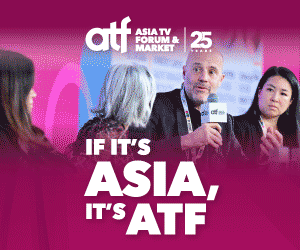
Young and bolshy 24-hour channel brand, Viceland, arrives in Asia this year in a slew of tie-ups across the region. In the midst of a significant rethink of the way video is packaged and presented in the region, is this a vote of confidence in the linear environment, more Shane Smith crazy, or a mix of both and then some?
Definitely a mix of both and more, laced with the hope that some of Smith's millennial magic and tone will rub off and light a fire under the butt of sluggish subscription TV growth in many parts of Asia.
Vice's rollout across the region is a tapestry of deals, arrangements and alliances that split the brand into linear TV and mobile/digital in some markets and bundle everything in others. The constant is Vice's tight control of programming and production.
The 24-hour youth-focused linear channel rolls out across Southeast Asia in an exclusive partnership with Gregg Creevey's Multi Channels Asia (MCA).
The linear deal is part of a global
expansion that Vice founder and chief executive, Shane Smith, spoke about
during this year's Cannes Lions event.
Separate deals – some of which include all-platform/digital rights – have been
done in India with The Times of India Group, Australia with SBS Australia and
Sky New Zealand for New Zealand.
In the Middle East/North Africa, Vice has tied up – not surprisingly – with the Moby Group. This is the latest move ina long-running bro-mance between Vice's Smith and Moby chairman/group chief executive,Saad Mohseni. Smith callsMohseni "a true media hero and one ofthe most unique visionaries in the global media landscape". Mohseni calls Smith a "visionary leader".
MIA (at least in public) at the moment are two major markets – China and Korea. No details on those yet.
Launch
dates from the partnerships had not been confirmed as of 1 July 2016. Some
of the services will roll out this year. In Southeast Asia, the linear channel
is scheduled to be up and running by early 2017.
Viceland for Southeast Asia will air culture, music, sports, fashion,
technology shows, all developed and produced by Vice Media's in-house team and
overseen by Oscar-winning film director Spike Jonze.
Vice is promising programming that will "focus on a distinct, immersive
style of original lifestyle and culture content for young viewers".
Smith's global ambitions are no secret.
During Media Partners Asia’s APOS event this year,he said South...
Young and bolshy 24-hour channel brand, Viceland, arrives in Asia this year in a slew of tie-ups across the region. In the midst of a significant rethink of the way video is packaged and presented in the region, is this a vote of confidence in the linear environment, more Shane Smith crazy, or a mix of both and then some?
Definitely a mix of both and more, laced with the hope that some of Smith's millennial magic and tone will rub off and light a fire under the butt of sluggish subscription TV growth in many parts of Asia.
Vice's rollout across the region is a tapestry of deals, arrangements and alliances that split the brand into linear TV and mobile/digital in some markets and bundle everything in others. The constant is Vice's tight control of programming and production.
The 24-hour youth-focused linear channel rolls out across Southeast Asia in an exclusive partnership with Gregg Creevey's Multi Channels Asia (MCA).
The linear deal is part of a global
expansion that Vice founder and chief executive, Shane Smith, spoke about
during this year's Cannes Lions event.
Separate deals – some of which include all-platform/digital rights – have been
done in India with The Times of India Group, Australia with SBS Australia and
Sky New Zealand for New Zealand.
In the Middle East/North Africa, Vice has tied up – not surprisingly – with the Moby Group. This is the latest move ina long-running bro-mance between Vice's Smith and Moby chairman/group chief executive,Saad Mohseni. Smith callsMohseni "a true media hero and one ofthe most unique visionaries in the global media landscape". Mohseni calls Smith a "visionary leader".
MIA (at least in public) at the moment are two major markets – China and Korea. No details on those yet.
Launch
dates from the partnerships had not been confirmed as of 1 July 2016. Some
of the services will roll out this year. In Southeast Asia, the linear channel
is scheduled to be up and running by early 2017.
Viceland for Southeast Asia will air culture, music, sports, fashion,
technology shows, all developed and produced by Vice Media's in-house team and
overseen by Oscar-winning film director Spike Jonze.
Vice is promising programming that will "focus on a distinct, immersive
style of original lifestyle and culture content for young viewers".
Smith's global ambitions are no secret.
During Media Partners Asia’s APOS event this year,he said Southeast Asia made Vice “kind of drool” because of the “tremendous young population, somewhat connected, very thirsty for more, and wanting a lot of content”.
"Easy" is not a word that's being bandied about here.
Pay-TV subscriber growth in Southeast Asia will grow 4% a year over the next five years to reach 36 million subscribers by the end of 2021, according toanalysts Media Partners Asia (MPA).
Most of that will come from the Philippines and to some extent Vietnam, which MPA expects to grow 10% over the next five years.
Pay-TV subscriber growth in other Southeast Asian markets appears bleak with most growth reliant on ARPU gains and a repackaging of tiers that refocuses on mini bundles and basic tiers built around strong existing brands and viable new brands as unworkable channels are gently or noisily retired.
Subscriber growth, especially satellite driven growth in Indonesia, is flat to down and payments to channel suppliers is uneven. Pay-TV penetration will still be 15% max in 2021, MPA data shows.
Singapore is down, with revenue growth of 1.5% to 2% over the next five years.
Malaysia is also flat though ARPU gains from non-linear services will help boost Astro; MPA expects the whole market to grow no more than 3% over the next five years.
As for Thailand, who knows. MPA expects growth of 2% to 3% over five years.
Southeast Asia's pay-TV revenue will be up 5% (CAGR) by the end of this year to US$4.4 billion, growing to US$5.7 billion by 2021. Ad sales is higher in some markets than others, but subscription will still make up 85% of that pie, says MPA executive director, Vivek Couto.
Couto says the Vice deals announced so far include a good combination of large-scale markets and major media groups, plus aspiring growth markets which could tap Vice’s local production efforts in Australasia and Indonesia.
In Southeast Asia, MCA is the largest and best indie distributor and in New Zealand, the partnership with Sky TV, now set for a combination with Vodafone, is one top watch. The big gaps are the lack of Foxtel in Australia and the lack of partnership in Korea, Asia’s second most scalable and accessible pay-TV market after India, where Vice has big plans with Times of India.
There's also no doubting the draw of an attention-grabbing, clutter-busting brand like Vice, which could put Viceland at the front of the queue for new carriage deals among operators desperate to drive subscription and to win a bit of the ellusive millennial head-space.
Creevey says the Viceland deal is "not just a confidence in linear TV, but a vote of confidence in finely focused linear TV as a focal point".
This hyper-focus is a line for which MCA is well-known, launching Outdoor Channel five years ago and following up with the millennial focused Havoc and more recently The Qyou.
The Viceland deal "is a great validation of the concept and the approach that we have to targeted thematic channels," he says, adding: "It proves that we are on the right path and that's where the market is moving".
The future, he says, is "more about channels that provide an opportunity to really engage with content, albeit with a narrow target audience".
MCA is going for basic carriage for Viceland. "If a platform wants to attract millennials, there can't be too many barriers in terms of tiering," Creevey says.
Viceland arrives as pay-TV operators across the region rethink their packages, clean house, and move towards skinny (or core) bundles divided into premium and cheap/cheerful basic, with not much tolerance for woolly, ill-defined services in the middle.
Creevey notes a "thinning of the herd" in packages that have become bloated with brand extensions and stocking-filler channels.
The MCA deal does not include digital/mobile rights. Creevey says the focus is firmly on the TV channel proposition, but that "we will be able to tap into online content".
Smith doesn't actually give a damn where his content is as long as it's seen.
Echoing industry leaders everywhere, he says this is "the best time ever in history to be a content provider".
"Everyone is talking about Netflix, and SVOD, and is it going to be OTT, VR, TV and … I don’t care because I'm the content provider. The more Netflixes there are the more bidders there are for my content. The more TV channels there are, the more apps, handheld devices... It’s better for me. As a content provider, it’s a fantastic time to be alive," he says.
Smith says mainstream media consolidation will continue and new media's prioritisation of scale over money will end. "That always comes home to roost," he says.
"I'm a very simple guy. When we did the magazine, it was one page of content and one page of ads. We kept thatphilosophy. Everything has to pay for itself. We can’t debt finance. We can’t raise money to finance the business. We have to finance the business on its own merits and then we can raise money to build growth and buy new companies. Luckily I was proved right," he says.
"There is going to be a massive consolidation in the online world... because there is downward pressure on price points from programmatic. If you are not involved in lots of different pies then you are in trouble," Smith says.
There's trouble too for companies relying solely on social media platforms.
"If you are... relying on Facebook for mobile video, if you are relying on YouTube, which many companies are, then you are in deep trouble because those guys work for YouTube and Facebook and not for you," he adds.
Smith calls Southeast Asia Vice's "last great frontier for us".
"There is so much happening, so much opportunity. We just have to get some boots on the ground and make sense of the madness, try to unite the tribe," he says, citing no lack of money or backing from brands.
He's also a huge believer in linear television if the model is right.
The example he uses is The Creators Project, launched in 2009 and backed by Intel. The platform today includes videos such as "Inside the Design of Nonotak's Infinite Space" and "The Making of Doris Sung's Heat-Responsive Chandelier", both part of the Future Forward partnership between The Creators Project and Toyota's new Prius.
Once production costs are covered by brands, "every time you sell the show, it's then 100% margin, and you go, 'this is fantastic'," Smith says.
His evolution as a media mogul continued at mainstream TV markets.
"Then I go to MIP TV for a week and sell to20, 30, 40, 100 countries and I make money forever. We should do this all day long, which is why we moved into TV. And then you do a FremantleMedia deal for a package and they sell it for you. You don’t even have to go to MIP. They just send you the cheques, and you say this is an even better business, we should do this all day long. And then you realise there’s an even better business if you own the platform, and then you just get money in subs fees. We can pay for all of our content creation with subs fees and send it all around the world. 100% margin. Everyone is asking why we are doing TV and I say, 'Because I want to make 100% fucking margin, as everyone else is making zero margin'. Then I win. It’s easy. I‘m not visionary.”
If anyone is not making money it's because the metrics are off.
"We were one of the first to do online video. We got destroyed for it," Smith says. In those days, life online was all about page views and click. Then it had to be engagment and scale.
"We just had people who were watching our stuff... We were in the wilderness for 10 years," he says.
Smith's view is that the metrics are still wrong.
"I do eight million uniques a day on Snapchat and I don’t get any metrics for it. Everyone is going for that scale. If you need 12 billion of anything to make money, you’re in the wrong business," he says.
"The main metric shouldn’t be scale, it should be CPMs. We knew that, as programmatic pushed things down, we had to stay premium," he says.
Midflight, Vice changed direction. "We changed everything on pricing, going direct to brands, building out our agency capabilities, changing the whole system to stay at high CPMs and 100% margin, rather than the new media at zero margin. I want a lot of cash flow, the more the better," he says.
If production/post-production houses are suffering, it may be because they have priced themselves out of the market, Smith says.
The reason Vice does everything in-house – from sound to colour correction – is simple: cost.
"When first started, we would go to the post houses, and everyone loved it because they treat you like royalty – and they charge you an arm and a leg for everything. I said we can never come here again," he recalls.
So he started hiring, against competition for talent from established houses, where "someone gives them a steak and a bottle of wine and a hat and a golden toilet… and we’re locking them into a room until they are finished".
Against this backdrop, many didn't want to work for Vice, which Smith says "was good, because we hired kids out of school and they go: “you’re going to let me cut something… this is awesome”.
At the same time, he's a big believer in partnerships and alliances of people and companies good at different things.
"Mainstream people should be worried if it's someone else other than me because I'm happy to work with them," he says. For now. Or until he feels 25% market share can be pushed to 50%. Or more. And then everyone will get shoved out."It's probably what we will try to do eventually, but in the meantime we're everyone's friend," he says.
He has no problem sharing his secrets.
"I always tell everyone all my secrets because the problem is that they just won’t do it," he says.
"Everyone wants to do online video. We were one of the first to do it so we made a lot of mistakes a long time ago. Everyone wants to come out and see our stuff. We know why they’re coming – they’re coming to figure it out. We show it to them. It’s fine," he says.
He's seen it over and over. "I tell them what’s going to happen. You’re going to leave here and spend 90% of your budget and it’s not going to work and you’re going to come back to me and say I have 10% of my budget left, can you do something with it."
"They all do the same thing, which is, they go back and say they know what they need now – 400 edit suites, all these editors, this that and everything else. And then they go to their board, and the board says are you crazy, do four, do 14. And then they hire TV people and editors and commercials editors and all this stuff and they spend 30, 40 50 million dollars and they make two hours of content. And then they do the math and realise they need 2,000 hours of content. So they’ve blown their budgets on two hours, they won an award and integrated something,” Smith says.
That's not what an online video business is made of. At least not to Vice.
Smith says Vice uploads something like 7,000 posts a day and half of them are video.
"We do thousands and thousands of hours of video. And it’s all in-house," he says.
"At some point, major companies come out of the pond and say 'we can’t do this’. It’s going to cost a billion dollars just to staff up and build the infrastructure. And even then, who knows if we are actually going to get there. Who knows if it’s going to be good. Because that’s the other thing, you can have all the infrastructure, but the content has to be good and people have to want to watch it and you have to be able to market it. They just realised, shit, we can’t do this and they come back to you and you either take their money and come up with a plan or you say you should have given me the money in the first place."
How much does Smith think is ok to spend on a show?
"There's no answer," he says. "You need all kinds of content – high-end stuff, tentpoles to market around, to hang your brand on, win awards. Programmes such as Vice News "The Islamic State", which involved Vice embedding with ISIS,are expensive.Long tail stuff is expensive.But you also need short little stings that are cheap but sticky".
Vice spends between US$5,000 and US$500,000 on 22 minutes of video.The most popular video of all time cost US$5,000 and something like 800 million video views across all platforms. "Cost is no predictor of success," he says.
One of the big questions is how Vice's content will go down in Asia, with censorship and content codes that might not be so friendly to programmes that curse a lot and talk about weed. And gay rights, and other stuff that freak out censors.
Smith is more focused on reaching an under-served audience. "There's no millennial food content. There's no weed content, and it's the most popular thing for young people," he says.
What's his tolerance for failure?
"Oh, we fail all the time," he says.Nevermind. Does it mean he stops trying. Hell no."You just have to go in and fuck shit up."
Amen.



















